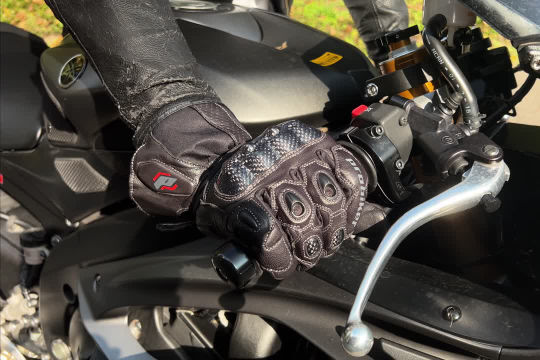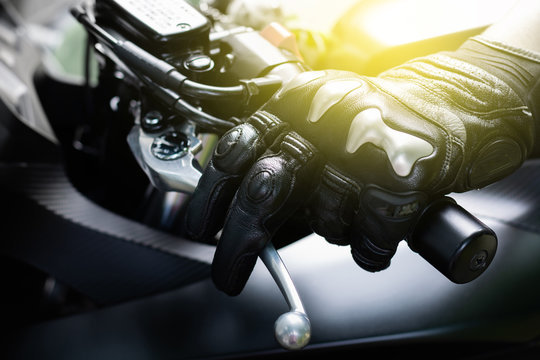Shifting gears on a motorcycle differs from shifting gears in a car or truck, and many new riders may not have manual transmission experience. It can take some time to master the basics of shifting smoothly, but with practice, novices can wind up shifting like total pros.

While theoretical information will only take you so far, we’re going to cover some of the basics to help any rider move towards mastering the art of smooth shifting.
The Throttle, the Clutch, and the Gears
There are three basic controls to operate when shifting a motorcycle – the throttle, the clutch, and the gear selector. The throttle revs the engine, the clutch engages and disengages the transmission, and the gear selector selects the gear.
 The throttle on a motorcycle is a control mechanism that regulates the amount of fuel and air entering the engine, ultimately determining the engine's power output. It is typically controlled by a handgrip on the right handlebar and is directly connected to the carburetor or fuel injection system. When you twist the throttle towards you (rolling it open), you increase the amount of fuel and air entering the engine, which leads to an increase in engine RPM (revolutions per minute) and, consequently, the motorcycle's speed. Conversely, when you release the throttle or twist it away from you (rolling it closed), you reduce the fuel and air flow, slowing down the engine and the motorcycle.
The throttle on a motorcycle is a control mechanism that regulates the amount of fuel and air entering the engine, ultimately determining the engine's power output. It is typically controlled by a handgrip on the right handlebar and is directly connected to the carburetor or fuel injection system. When you twist the throttle towards you (rolling it open), you increase the amount of fuel and air entering the engine, which leads to an increase in engine RPM (revolutions per minute) and, consequently, the motorcycle's speed. Conversely, when you release the throttle or twist it away from you (rolling it closed), you reduce the fuel and air flow, slowing down the engine and the motorcycle.
The clutch of a motorcycle is a crucial component that allows the rider to disconnect the engine from the transmission temporarily. When you pull in the clutch lever, you disengage the clutch, separating the engine from the transmission. This disconnection is necessary for shifting gears smoothly and efficiently. After shifting gears, you gradually release the clutch lever. As you release the lever, the clutch plates engage, re-establishing the connection between the engine and the transmission. The clutch is operated by a lever typically located on the left handlebar, known as the clutch lever.
The motorcycle gear pattern is selected by clicking a lever with your left foot. With the clutch lever pulled in, you use your foot to shift gears. The gear shifter is typically located in front of the left footrest. Most motorcycles have multiple gears, usually ranging from four to six. Each shift moves the transmission into a different gear ratio. Riders use the toe of their left boot to move the shifter up and down. Most bikes have a “first down, rest up” gear pattern . That means the first gear is at the bottom of the lever’s range. Neutral is directly above first gear, and second gear is directly above neutral. The gears go up sequentially from there. So, for a five-speed motorcycle, the pattern from the bottom up is 1N2345, where “N” is for neutral. While this pattern is typically the norm, there are some bikes that reverse this with a "first up, rest down" pattern. In addition, some motorcycles have a shift lever controlled by both the heel and the toe (called a heel-toe shifter or a rocker shifter) with one side for shifting up and the other side for shifting down
(Source: Matt Laidlaw - Youtube)
What are the gears on a motorcycle?
When you start your motorcycle or need maximum torque for slow speeds, motorcycles with the "first down, rest up" pattern require you to engage first gear by shifting the gear level down. First gear provides the most mechanical advantage but also the least speed. It is used for initial acceleration and slow-speed maneuvering.
As you gain speed, you shift up through the gears. Each higher gear provides a higher speed range but reduces the mechanical advantage, making the engine run more efficiently at higher speeds. Shifting up through the gears allows the motorcycle to achieve higher speeds while maintaining optimal engine performance.
When you need to reduce speed or prepare for a stop, you downshift by engaging the clutch lever by pulling it towards you and pressing the gear lever down with your foot. Each downshift moves to a lower gear, providing more mechanical advantage and engine braking. Downshifting is crucial for maintaining control and stability when decelerating.
Between first gear and second gear is the neutral position. When the motorcycle is in neutral, the engine is disengaged from the transmission, allowing the bike to idle without moving forward or backward. Neutral is typically located between first and second gears, and you find it by a half-click down from second gear. Many bikes also have an indicator or light on your instrument panel to provide a visual that you are in neutral.
Shifting Technique
Having the proper technique is vital to a smooth shift. To shift correctly, the rider needs to perform a series of actions in sequential order in a deliberate and even manner. For the "first down, rest up" pattern, the sequence is as follows:
- Engage the clutch
- Select the correct gear
- Give it a little throttle
- Release the clutch slowly
- Feather the throttle while letting out the clutch
- Throttle up and rev until the next change
The actual mechanics of making a motorcycle go are relatively simple, but doing it smoothly, as is the case with most things, requires practice. Half the battle is knowing your motorcycle controls – the layout, how they operate, their quirks and unique characteristics – because all great musicians understand their instrument as well as they understand the music.
Also think about where you will practice. As a beginner, a large open space with little or no traffic is ideal for your safety and the safety of those around you. The more you practice, you will likely find it quite easy to ride a motorcycle. Once you get the clutch feeling, gear matching, and how much throttle is necessary to accelerate smoothly, the process will be much easier and it will require less focus.
Shifting Tips
Tip #1 - Listen to the sounds of the engine as you shift. You can learn a lot about optimal shifting just from listening to the noises as you work your way through the gears.
Tip #2 - Many riders think of the clutch as a switch that is either on or off. You should think of the clutch as a progressive control that can be used to allow some of the power the motorcycle is producing to flow to the rear wheel.

Riding the motorcycle slow with the clutch fully engaged means that you must use the throttle to control speed. This results in very jerky control of the bike. At slow speeds, the clutch lever should be held at the “friction zone”, the point in its travel that allows the clutch to continually slip. This slippage should continue for the whole duration of the low speed maneuver, so that minute movements of the lever will allow more or less power to be released at your discretion.
If you use the throttle in an attempt to control the motorcycle, you will go faster. Going faster while performing a low speed maneuver will cause the motorcycle to straighten up, resisting the effort to make it turn. If you slip the clutch while increasing the amount of throttle, then what is produced is more power, not more speed.
More power is helpful in preventing stalling of the motorcycle. Keep in mind that anytime more throttle is used, the clutch must be in the friction zone.
Tip #3 - Sometimes while using the clutch and throttle together to control the motorcycle the bike will pick up too much speed. To safely perform the maneuver the rider needs to slow down.
Tip #4 - Downshift one gear at a time.This will give you more control over the motorcycle and ensure that you have power available if you need to make a quick move or adapt.
Tip #5 - Release the shift before passing the redline. You can do a lot of damage by stressing the engine beyond its limits. Be aware of your revs. If you shift when the revs are too low, you will have no power and could stall the bike.
-
A smooth shift can help enhance the entire riding experience. It makes the bike easier to handle and keeps the chassis loaded, creating a more stable ride. A smooth shift approach is safer, and gives the rider more time to provide inputs and control the motorcycle. Shifting smoothly will require some practice. The good news is, once you’ve committed it to muscle memory, you’ll be a smoother, safer, better rider!

